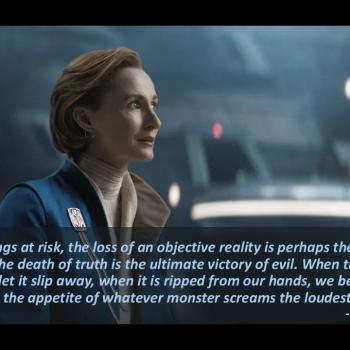Review of James A. Herrick, Scientific Mythologies: How Science and Science Fiction Forge New Religious Beliefs (Downers Grove: IVP, 2008).
Some books are annoyingly bad, but others may seem even more annoying because they had the potential to be excellent, and yet in the end are marred by a narrow ideological slant, apologetic interests, and/or an inability to examine their own worldview as critically as that of their opponents. James A. Herrick’s Scientific Mythologies falls into this latter category. Although it is filled with much that is interesting and even important, like so many works of apologetics, it has little to say to anyone who did not already assume the book’s conclusions before they began reading.
 Herrick’s chosen subject is an important one. Much has been written and many views promoted at the intersection between science (or, more precisely, speculative science), science fiction, and religion. Many ideas that are by no means new or innovative somehow seem more plausible if they are couched in scientific-sounding terms. Herrick’s purpose is “to explore the various ways in which the Western world’s present spiritual needs are being addressed by a new mythology, an emerging canon of transcendent stories that provides meaning to our lives and that organizes and directs our individual and social decisions…Lurking in the background of this discussion will be the question of whether our largely unexamined new mythologies actually represent what their advocates claim for them – that they are a much-needed alternative to more traditional perspectives on God, people, and the destiny of the human race, an alternative that will open a spiritual pathway into the increasingly technological future” (p.13).
Herrick’s chosen subject is an important one. Much has been written and many views promoted at the intersection between science (or, more precisely, speculative science), science fiction, and religion. Many ideas that are by no means new or innovative somehow seem more plausible if they are couched in scientific-sounding terms. Herrick’s purpose is “to explore the various ways in which the Western world’s present spiritual needs are being addressed by a new mythology, an emerging canon of transcendent stories that provides meaning to our lives and that organizes and directs our individual and social decisions…Lurking in the background of this discussion will be the question of whether our largely unexamined new mythologies actually represent what their advocates claim for them – that they are a much-needed alternative to more traditional perspectives on God, people, and the destiny of the human race, an alternative that will open a spiritual pathway into the increasingly technological future” (p.13).
The reference to those other views as “alternative”, and the Christian one Herrick takes for granted as “traditional”, warns the attentive reader of a problematic slant the author has from the outset. For Herrick will rightly point out that some of the views that are coming back into favor are in fact rather ancient. Indeed, the author delights in sticking the warning label “pagan” on numerous other viewpoints. Yet this point ought to lead naturally to an acknowledgment that at one time those ideas were traditional, just as Christianity was once alternative (see p.41 as just one place where this issue ought to have been addressed but is not). And so, although the book’s back cover makes reference to “our post-Christian West”, in fact, the book demonstrates clearly the author’s inability to understand, and thus adequately address, that very situation. One example can be seen on p.27, where Herrick writes that “our scientific mythologies are a powerful cultural engine for inventing and for propagating a worldview that stands in marked contrast to, and seeks to move audiences away from, traditional monotheistic religious perspectives, in particular the Judeo-Christian tradition” (see also pp.38-39). This is not the voice of a Christianity confident in telling its own story in the context of contemporary pluralism, but the whine of beleaguered Christendom. This will become clear time and again throughout the book.
The introduction and the chapter that follows (entitled “New Myths for a New Age”) set the stage for what is to follow. Science fiction, it is rightly pointed out, aims not merely to entertain but to persuade (p.26). This could be said of much literature, and specifically much fiction. Does the Left Behind series not aim to persuade more than (I am tempted to say “rather than”) entertain? Be that as it may, it is certainly true that stories and in particular science fiction films and television have made certain speculations about the future (and indeed, the present in other parts of the universe) seem more plausible, aided by the latest in animation and special effects. Early in the second chapter, Herrick mentions the sense many have that older religious ideas are outmoded, and that there is a need for new thinking in response to our new scientific knowledge. If only Herrick had a greater familiarity with the historical depth and breadth of the Christian tradition, he might have been able to highlight some of the interesting ways in which Christians have always reinterpreted and re-expressed their faith in response to changing contexts and progressing knowledge. Alas, instead such voices tend to be placed in opposition to Herrick’s own viewpoint, which he considers to be simply a telling of “the old old story”, and yet which is itself more fundamentally shaped by modernity than Herrick seems to know. We see this as he speaks of the creation by science and science fiction of “new myths” to replace “old creeds” (p.29). Not only does this reflect one particular understanding of the Christian faith as inherently creedal, as a set of propositions to which one ought to give one’s assent. It also places “myths” and “creeds” in an opposition to one another that is at best odd and at worst misguided.
Vagueness about what Herrick means by “myth” permeates the book, but he seems to assume that its meaning is pejorative (even though he offers a quotation to the contrary on pp.31-32) and he refrains from using the term in relation to Christianity. Yet if one means by myth “stories by which we interpret our experience and which give expression to our core values”, then Christianity clearly has such stories to offer. Likewise, if one means “stories that interpret the world using language that does not match the best understanding modern science can offer”, then here too Christianity has “myth” to offer in its Sacred Scriptures and other writings of the Christian tradition. Herrick is right to quote Mary Midgley’s dictum that “we do not have a choice of understanding it [viz. the world] without using any myths…at all” (quoted p.36), although he seems not to fully grasp its meaning, much less its implications for Christianity. And while he rightly describes contemporary “myths” as “blending well-substantiated facts with freewheeling speculation, scientific research with straight fiction, and objective observation with subjective worldview peddling” (p.36), one would have to be quite blind not to see how well this description applies to much popular Christianity. Above all else, it is the author’s unwillingness or inability to critically investigate parallel weaknesses within a Christian context that most powerfully undermines the important things the book has to say.
As Herrick concludes his second chapter, he returns once again to a facile contrast between the Judeo-Christian tradition (as though this were something monolithic and easily essentialized) and the new myths. If his approach were not so lacking in humility and self-criticism vis-à-vis his own heritage, it would be easier to acknowledge that the question Herrick is asking is a valid, and indeed an important one. Many make the same simplistic contrast Herrick himself does, between Christianity (treated as the monolithic and clearly outmoded tradition) and everything else (treated as new, fresh and exciting). Yet much that has gained in popularity in our post-Christian society is neither more scientific nor more compatible with science than Christianity, neither newer nor less mythical nor more obviously “better” than the tradition they are discarding. But in order for Christianity to make the best case for itself that it can, there is a need for religious conservatives to let go of the pompous arrogance of Christendom, and to rediscover the resources not merely to say traditional words, but to relate traditional meanings to a world and worldview very different from that in which the Biblical authors wrote.
 The chapters that make up the remainder of the book examine specific “myths” of contemporary science fiction religion. Each chapter reads much like the works of the heresiologists of the early church. Key individuals who have propounded new ideas in the realms of speculative science, science fiction and religion are mentioned, together with a summary of important and often less well-known writings of theirs and an overview of their key claims and ideas. The first to get such treatment (in chapter 3) is “The Myth of the Extraterrestrial”. As with most of the chapters, rather than work chronologically, the chapter jumps from epoch to epoch. This is particularly significant in chapter 3, however, because as Herrick acknowledges, the possibility of extraterrestrial life is not new to Western thought in general or the Christian tradition in particular (pp.52-53). Yet rarely if ever does Herrick acknowledge that discussions of this topic arose naturally from Christian theological presuppositions (pp.45-46). When a Christian theologian such as Nicholas of Cusa engages such issues, Herrick suggests that it is due to borrowing from the philosophies of Islamic Spain, which he claims were rooted in “Zoroastrianism and Persian astrology” (p.46). Herrick seems unaware that Islamic philosophy was rooted in Greek philosophy, and indeed was the means whereby European thinkers rediscovered Greek philosophy after the “Dark Ages”. But just as the propaganda movie Expelled avoided including Christians who are scientists persuaded by the evidence for evolution, since it would spoil the culture war the movie seeks to foster, so to Herrick seems to assume that anyone who takes seriously these thoughts about extraterrestrials must in some way be connected with paganism, the occult, or materialism. Alas, those who are actually familiar with Biblical studies or the history of Christian thought know that there is no way to simply draw such a firm dividing line, with everyone lined up nicely into two opposing camps.
The chapters that make up the remainder of the book examine specific “myths” of contemporary science fiction religion. Each chapter reads much like the works of the heresiologists of the early church. Key individuals who have propounded new ideas in the realms of speculative science, science fiction and religion are mentioned, together with a summary of important and often less well-known writings of theirs and an overview of their key claims and ideas. The first to get such treatment (in chapter 3) is “The Myth of the Extraterrestrial”. As with most of the chapters, rather than work chronologically, the chapter jumps from epoch to epoch. This is particularly significant in chapter 3, however, because as Herrick acknowledges, the possibility of extraterrestrial life is not new to Western thought in general or the Christian tradition in particular (pp.52-53). Yet rarely if ever does Herrick acknowledge that discussions of this topic arose naturally from Christian theological presuppositions (pp.45-46). When a Christian theologian such as Nicholas of Cusa engages such issues, Herrick suggests that it is due to borrowing from the philosophies of Islamic Spain, which he claims were rooted in “Zoroastrianism and Persian astrology” (p.46). Herrick seems unaware that Islamic philosophy was rooted in Greek philosophy, and indeed was the means whereby European thinkers rediscovered Greek philosophy after the “Dark Ages”. But just as the propaganda movie Expelled avoided including Christians who are scientists persuaded by the evidence for evolution, since it would spoil the culture war the movie seeks to foster, so to Herrick seems to assume that anyone who takes seriously these thoughts about extraterrestrials must in some way be connected with paganism, the occult, or materialism. Alas, those who are actually familiar with Biblical studies or the history of Christian thought know that there is no way to simply draw such a firm dividing line, with everyone lined up nicely into two opposing camps.
Giordano Bruno may well have been a heretic in the eyes of many different branches of Christianity in his time, but so too was Isaac Newton. Yet even though Herrick does not mention Newton by name, Herrick lifts up Christianity as providing the basis for the scientific enterprise. Selectively reading and citing history will not persuade those who know a subject well. And so the aim seems to be apologetics targeting those who are among less well-informed Christians, inclined to see the world in the same black-and-white, us vs. them way that Herrick does. The truth is that there have been Christians both in the sciences and in opposition to them; Christians speculating about extraterrestrials while other Christians denounced such speculations. Neither viewpoint is simply “the Christian viewpoint”.
Herrick repeatedly mentions the lack of scientific evidence for extraterrestrial life (pp.48, 72). On this point he is quite correct, yet still not entirely fair. Herrick quotes Michael Crighton as pointing out that after 40 years of searching there is still no evidence (p.72). Yet humans dreamed of flying for much longer than that before achieving it (see p.81). The existence of life elsewhere is still a matter of speculation rather than confirmed fact, but it is reasonable, well-informed speculation. It would make sense to ponder the issue before it becomes an urgent matter of fact, since once it does it will be much harder to think clearly and with any degree of objectivity. Herrick’s lack of clarity on the meaning of “myth” returns at the end of this chapter, when he asks whether national policy on the scientific search for extraterrestrial intelligence has “been driven by a Myth” (p.72). Earlier he seemed to acknowledge that myth is more than simply pre-scientific explanation, and that we cannot do without stories that embody our values. Would Herrick equally object to the myths that affirm the equal worth of all human beings guiding public policy? A clear, accurate discussion of myth and values, and their relation to policy, would have been helpful here.
 What is quite possibly the most interesting subject of all, namely how one makes sense of extraterrestrials within a Christian framework, is never addressed directly (cf. p.53). The same is true of our modern scientific cosmology and its displacement of earlier understandings (including, but not limited to, those cosmologies reflected in the Bible). In his chapter 4, “The Myth of Space”, Herrick alludes to how science has turned “the heavens” into “space”, yet he never really addresses either the parallels or the relationship between them. One could suggest that ancient Jewish apocalyptic was a form of early “science fiction”, in the sense that it involves humans travelling to the heavens and meeting strange celestial beings, and at times also the latter visiting earth (and even providing humans with advanced technology and interbreeding with them). Neither Hebrew nor Greek distinguished between “heaven” and “sky”, since the assumption was indeed that the dwelling place of God and angels was “up there”. What does one do with stories such as Luke’s story of the ascension of Jesus, in which he goes up into the sky and it is understood as his being exalted to the right hand of the Father? How does one make sense of it in the context of our current understanding of the universe? Addressing such questions, taking them seriously, seems a more worthwhile endeavor than the castigation of those who dare to ask them and reach conclusions Herrick finds unacceptable. At any rate, Herrick only goes back to the seventeenth century, whereas here too much earlier stories of celestial journeys ought to have been included, as they provide a natural point of contact between the “Judeo-Christian tradition” and modern science fiction. In a nice quote, Herrick points out that “What makes SETI scientific is not the absence of propelling myths – for those are clearly at the forefront in SETI – but the presence of telescopes” (p.92). But Christians have looked through telescopes too, ever since they were invented, and have sought to find ways of relating their faith heritage to what they saw there.
What is quite possibly the most interesting subject of all, namely how one makes sense of extraterrestrials within a Christian framework, is never addressed directly (cf. p.53). The same is true of our modern scientific cosmology and its displacement of earlier understandings (including, but not limited to, those cosmologies reflected in the Bible). In his chapter 4, “The Myth of Space”, Herrick alludes to how science has turned “the heavens” into “space”, yet he never really addresses either the parallels or the relationship between them. One could suggest that ancient Jewish apocalyptic was a form of early “science fiction”, in the sense that it involves humans travelling to the heavens and meeting strange celestial beings, and at times also the latter visiting earth (and even providing humans with advanced technology and interbreeding with them). Neither Hebrew nor Greek distinguished between “heaven” and “sky”, since the assumption was indeed that the dwelling place of God and angels was “up there”. What does one do with stories such as Luke’s story of the ascension of Jesus, in which he goes up into the sky and it is understood as his being exalted to the right hand of the Father? How does one make sense of it in the context of our current understanding of the universe? Addressing such questions, taking them seriously, seems a more worthwhile endeavor than the castigation of those who dare to ask them and reach conclusions Herrick finds unacceptable. At any rate, Herrick only goes back to the seventeenth century, whereas here too much earlier stories of celestial journeys ought to have been included, as they provide a natural point of contact between the “Judeo-Christian tradition” and modern science fiction. In a nice quote, Herrick points out that “What makes SETI scientific is not the absence of propelling myths – for those are clearly at the forefront in SETI – but the presence of telescopes” (p.92). But Christians have looked through telescopes too, ever since they were invented, and have sought to find ways of relating their faith heritage to what they saw there.
In a similar vein, Herrick seems surprised that science fiction writers tell stories in which travelers in space encounter deceased relatives (as in Contact and Solaris, for instance). Yet Christians speak regularly about “going to heaven when you die”, and as a cosmology in which heaven is literally “up there” is replaced with space above and around us, it is natural to explore such questions. The answers given by various writers may be open to criticism, but the line of inquiry itself should not be surprising.
Herrick notes C. S. Lewis’ concern about space exploration deriving from Psalm 115:16, “The heavens are the LORD’s heavens, but the earth he has given to human beings” (see pp.88-89). He also asks whether such as whether such explorations can be justified in view of more immediate, pressing concerns such as poverty (pp.90-91). I hope most people will concur that there is something troubling about searching for intelligent beings who might exist while ignoring those around us who clearly do exist and are in desperate need of our help. Yet understanding our place in the universe and discovering new technologies that can help alleviate poverty are themselves important, and ideally one might hope that science and exploration would be prioritized below matters of social justice but above other things we spend our money on. Western wastefulness and luxury seem to be the issues most directly standing in the way of alleviating poverty, rather than space explanation or other areas of scientific investigation.
Herrick makes an important point at the end of chapter 5, which is probably one of the most important ones in the book. As we’ve spread our influence and control across the earth, we’ve often done so in ways that have shown us to be lacking in moral guidance and principles. To assume that once we get into space, things will be different, is unrealistic. We cannot escape from ourselves and human nature in space. If we wish to have a future in space that is morally different, with poverty and injustice left behind as things of the past, then we must address those issues in ourselves in the present (p.96). This leads naturally into chapter 5, “The Myth of a New Humanity”. Herrick declares this one of the most dangerous of the new mythologies he includes in his book (p.98), and he is undoubtedly right. Genetic manipulation, eugenics, technological enhancement and supplementation of our biological beings, and other such subjects treated in this chapter are indeed extremely pressing concerns.
In this chapter, Herrick rightly addresses a common mythological misappropriation of evolution in popular thought. Many think of evolution as progress. But while competition for resources have led to beneficial adaptations, there is simply no reason to think that the survival of the fittest will lead to spiritual progress, or endow us with telepathy, flight, and other seemingly supernatural abilities, as in the X-Men or Heroes. Herrick brings up the connections between science fiction and notions of a “superior race”, often coupled not merely with racism but the idea of manipulating human evolution through selective breeding or eugenics. In more recent times, interest in selective breeding has been lessened as the possibility of direct manipulation of the genome has become a real one (and it is unfortunate that Herrick appears to be unaware of the movie Gattaca which addresses this subject). At times, however, Herrick seems more interested in discrediting science fiction (particularly that of the first few decades of the 20th century) through their connection with racism. Yet rather than it being clear that sci-fi influenced this aspect of the “spirit of the age”, the reverse may be the case, since science fiction envisages the future in ways that reflect the views and values of the time in which it was produced.
 If one looks at the churches of the American South (for instance) both before and after that particular historical juncture, as well as more widely during that epoch, there is just as much evidence of Christians engaging in acts of evil and even interpreting the Bible in racist ways. Once again, a failure to apply criticisms fairly undermines the power of the criticisms. In addition to not fairly acknowledging Christians’ failings, Herrick also fails to mention science fiction’s successes. Star Trek was certainly pioneering in making an African-American woman an officer on the bridge of the starship Enterprise, and for offering the first interracial kiss on American television. Science fiction reflects the age in which it is written, but it has also dared to offer important challenges at times. The new Battlestar Galactica is comparably challenging in the ways it addresses issues like torture or our demonization and dehumanization of our enemies. It seems that placing a story in a science fiction setting allows issues to be addressed in ways that would be tolerated less easily if the story being told were happening here and now on Earth.
If one looks at the churches of the American South (for instance) both before and after that particular historical juncture, as well as more widely during that epoch, there is just as much evidence of Christians engaging in acts of evil and even interpreting the Bible in racist ways. Once again, a failure to apply criticisms fairly undermines the power of the criticisms. In addition to not fairly acknowledging Christians’ failings, Herrick also fails to mention science fiction’s successes. Star Trek was certainly pioneering in making an African-American woman an officer on the bridge of the starship Enterprise, and for offering the first interracial kiss on American television. Science fiction reflects the age in which it is written, but it has also dared to offer important challenges at times. The new Battlestar Galactica is comparably challenging in the ways it addresses issues like torture or our demonization and dehumanization of our enemies. It seems that placing a story in a science fiction setting allows issues to be addressed in ways that would be tolerated less easily if the story being told were happening here and now on Earth.
It is in this chapter that one of the most troubling aspects of Herrick’s book became apparent to me. In addressing H. G. Wells’ view of the masses of ordinary people as well as different races, Herrick depends largely on quotes from Wells that he received second-hand from other sources. This is not an isolated instance in the book. What is more, when one checks the primary sources, one finds that the quotations do not precisely reflect them. This is presumably a result of the use of second-hand sources (Herrick specifies that he is dependant on Carey’s Intellectuals and the Masses for the quotation, and never refers to Wells’ Anticipations). In our day and age, when many classic works of literature can be found online, there is simply no excuse for not checking the primary sources themselves. Here are the quotations from Herrick and Wells himself:
Herrick: The “nation that most resolutely picks over, educates, sterilizes, exports, or poisons its People of the Abyss will be in the ascendant” (p.107).
H. G. Wells, Anticipations (p.212): The nation that produces in the near future the largest proportional development of educated and intelligent engineers and agriculturists, of doctors, schoolmasters, professional soldiers, and intellectually active people of all sorts; the nation that most resolutely picks over, educates, sterilizes, exports, or poisons its People of the Abyss; the nation that succeeds most subtly in checking gambling and the moral decay of women and homes that gambling inevitably entails; the nation that by wise interventions, death duties and the like, contrives to expropriate and extinguish incompetent rich families while leaving individual ambitions free; the nation, in a word, that turns the greatest proportion of its irresponsible adiposity into social muscle, will certainly be the nation that will be the most powerful in warfare as in peace, will certainly be the ascendant or dominant nation before the year 2000.
In view of such an imprecise quotation in the one instance where I tried to verify Herrick’s source material, it is impossible not to wonder how accurately Herrick’s presentation of other individuals’ views reflects what they wrote in a fair and balanced way (see for instance p.114, where only secondary sources are cited in attributing views to Alexander Graham Bell, Thomas Watson, and Alfred Russell Wallace).
Abilities such as telepathy are often attributed to more “highly evolved” beings, whether human or alien. Yet scientific research has lent no support for the claims of parapsychology, and indeed has tended to undermine them. Here, the relationship between science, science fiction, and religion is rather complex. As Herrick notes, “Even among the religious faithful, two-thirds of Catholics and half of Protestants accepted ESP as true” (p.118). If science fiction has often incorporated such abilities, skeptics who demand scientific scrutiny have found no evidence (in spite of the Amazing Randi offering a million dollar reward to anyone who can demonstrate them under close inspection). Does the popularity of such notions even among Christians indicate that many of us are unwilling to subject our beliefs to such critical scrutiny? At the very least, this suggests that science and science fiction are not always allied, nor are they consistently lined up against the views held by Christians. But in some streams of Christian thought, believing without evidence, or even in spite of evidence to the contrary, is considered a virtue. Should it be any surprise when Christians are found to believe things that are not supported by our best scientific understanding, that are not backed by adequate evidence (if any at all)? If belief in extraterrestrials without clear confirmation is inappropriate, ought Jews and Christians to believe that the Exodus is a literal historical event? The challenge of taking evidence seriously, even when it challenges our assumptions and cherished beliefs, faces us all equally irrespective of our worldview.
 In the conclusion to this chapter, Herrick rightly points out that “Scientific data do not speak for themselves, and the blueprint for an improved humanity cannot be assembled from a mountain of facts about computer capacity and the human genome. A transcendent story about humanity and its destiny – a myth – will guide the creation of the New Humans” (p.126). Yet merely contrasting the scientific quest for an improved humanity with the Christian vision of the salvation accomplished through Christ’s death is an inadequate way of addressing this subject. The truth is that psychology, neuroscience, and biology have often at the very least supplemented traditional Christian approaches to human transformation – at times challenging them, at times supporting and enhancing. But simply contrasting them, as though the only option is to choose between the two, is clearly inadequate. The Christian tradition has always been in dialogue with those of other traditions, and if one were to say that anything “tainted” with pagan associations must be excised from Christianity, then not only science fiction, but also the prologue of John’s Gospel would have to go. “The Christian view” (for Herrick assumes that there is a single, monolithic Christian viewpoint) is once again said to be the “traditional” viewpoint (p.126), and Herrick contrasts its “preexistent creator God” with “Kurzweil’s lower deity of evolution”. But the challenge for Christians is not to hide from either the overwhelming evidence for evolution or from the possibilities for future technological enhancement of our lives, but to be voices for the ethical exploration of such possibilities. As Herrick rightly points out, the Biblical “myths” emphasize the equality of all human beings as descendants of a single ancestor “made in the image and likeness of God”. For Herrick, this seems to represent a stop sign to be held before further scientific progress along the lines that Ray Kurzweil and others have imagined. But for those who have already faced the challenge of making sense of the value of those Biblical stories in relation to our current scientific knowledge, the sign does not say “STOP” but “CAUTION: Danger Ahead”. For there is indeed a need for voices calling for the fruits of our technological explorations and discoveries to be used in an ethical manner, to better our lives rather than cause harm. But Herrick seems to fear such improvement of lives through technology, since each step may lead people to stop asking the questions for which his understanding of Christianity has pat answers already prepared.
In the conclusion to this chapter, Herrick rightly points out that “Scientific data do not speak for themselves, and the blueprint for an improved humanity cannot be assembled from a mountain of facts about computer capacity and the human genome. A transcendent story about humanity and its destiny – a myth – will guide the creation of the New Humans” (p.126). Yet merely contrasting the scientific quest for an improved humanity with the Christian vision of the salvation accomplished through Christ’s death is an inadequate way of addressing this subject. The truth is that psychology, neuroscience, and biology have often at the very least supplemented traditional Christian approaches to human transformation – at times challenging them, at times supporting and enhancing. But simply contrasting them, as though the only option is to choose between the two, is clearly inadequate. The Christian tradition has always been in dialogue with those of other traditions, and if one were to say that anything “tainted” with pagan associations must be excised from Christianity, then not only science fiction, but also the prologue of John’s Gospel would have to go. “The Christian view” (for Herrick assumes that there is a single, monolithic Christian viewpoint) is once again said to be the “traditional” viewpoint (p.126), and Herrick contrasts its “preexistent creator God” with “Kurzweil’s lower deity of evolution”. But the challenge for Christians is not to hide from either the overwhelming evidence for evolution or from the possibilities for future technological enhancement of our lives, but to be voices for the ethical exploration of such possibilities. As Herrick rightly points out, the Biblical “myths” emphasize the equality of all human beings as descendants of a single ancestor “made in the image and likeness of God”. For Herrick, this seems to represent a stop sign to be held before further scientific progress along the lines that Ray Kurzweil and others have imagined. But for those who have already faced the challenge of making sense of the value of those Biblical stories in relation to our current scientific knowledge, the sign does not say “STOP” but “CAUTION: Danger Ahead”. For there is indeed a need for voices calling for the fruits of our technological explorations and discoveries to be used in an ethical manner, to better our lives rather than cause harm. But Herrick seems to fear such improvement of lives through technology, since each step may lead people to stop asking the questions for which his understanding of Christianity has pat answers already prepared.
In chapter 6, “The Myth of the Future”, Herrick accuses preoccupation with the future of distracting from life and meaning in the present. This is certainly true, but it is also true that what we believe about the future can shape how we live in the present. And it is equally true that those forms of Christianity which place all their emphasis on an other-worldly afterlife have a similar outlook and even at times a similar effect. When he writes that “the future can acquire a religious quality, a vision of a better world to come that is modeled on a perfect world of the past” (p.137), I felt certain he would bring the Book of Revelation into the discussion, with its transforming vision of the future and its echoes of Eden. But here too Herrick seems unaware of how much that he finds problematic in science fiction exists deeply rooted within his own tradition as well.
When he brings Francis Bacon’s The New Atlantis into the discussion, he downplays that this is an attempt to allow science and Scripture to interact, and draws instead facile contrasts between scientific and spiritual wisdom (pp.139-140). In ancient Israel, Wisdom was not limited to the sorts of moral advice embodied in the Book of Proverbs, or explorations of the meaning of life and problem of evil such as are found in Job and Ecclesiastes. The New Atlantis, in viewing scientific wisdom as a divine gift (p.142), stands firmly in that earlier tradition that viewed God as the source of wisdom that included developments in areas like mining and medicine.
 In his conclusion to this chapter, Herrick alludes to the Biblical story of the Tower of Babel (p.156). But here too he seems insensitive to the difference between our perspective and the story’s. In Genesis, God is depicted as descending from heaven to cause the humans’ plan to fail. If Herrick truly believes that story is a literal factual account of a historical event, then his book is unnecessary: God will do the same to bring today’s human enterprises to naught if he is displeased. But in fact, all the evidence points to the Tower of Babel story being more akin to political satire, depicting the Babylonians’ great civilization as “confusion”, and their unfinished ultimate Ziggurat as testimony to this. Had Herrick been familiar with Biblical scholarship on this story, he might have found in it a Biblical model for poking fun at the lofty and at times haughty visions of humanity today.
In his conclusion to this chapter, Herrick alludes to the Biblical story of the Tower of Babel (p.156). But here too he seems insensitive to the difference between our perspective and the story’s. In Genesis, God is depicted as descending from heaven to cause the humans’ plan to fail. If Herrick truly believes that story is a literal factual account of a historical event, then his book is unnecessary: God will do the same to bring today’s human enterprises to naught if he is displeased. But in fact, all the evidence points to the Tower of Babel story being more akin to political satire, depicting the Babylonians’ great civilization as “confusion”, and their unfinished ultimate Ziggurat as testimony to this. Had Herrick been familiar with Biblical scholarship on this story, he might have found in it a Biblical model for poking fun at the lofty and at times haughty visions of humanity today.
Chapter 7 addresses “The Myth of a Spiritual Race”. In many respects this chapter is the most disappointing for its glaring inability to be self-critical. Although the criticisms made of the embracing of supposedly scientific eugenics in science fiction particularly of the nineteenth and early twentieth centuries, Herrick offers no acknowledgment of the church’s failure to be united in rejecting racism. On the contrary, as Herrick acknowledges, the myth of a superior spiritual race was for the most part focused on a white European race that had eventually become Christian (p.166). Racist interpretation of the Bible, understanding the mark of Cain as skin color, is infamous but never mentioned in Herrick’s book. Nor, in his treatment of Mormonism or elsewhere, does he deal with European Christianity’s frequent inability to make sense of the existence of Native Americans as human beings with souls, since it was inconceivable that God would have left human beings in far off places without the Gospel being sent to them. Indeed, the “extraterrestrial challenge” to Christianity is the same basic issue, enlarged onto a galactic or indeed universal scale. Rather than address why large numbers of Christians aligned themselves on issues like race or slavery in ways that we are today ashamed of, Herrick suggests that the only bulwark that could have been effective against the myth of race would have been “a fully formed Christian theology” (p.179). Herrick at this points speaks much like those whom Jesus criticized in the Gospels, who claimed that if they had been alive in the time of the prophets, they would never have persecuted and killed them (Matthew 23:29-36). This option is always a popular one: to think that if I had been around back then, I surely would not have been deceived. This is but one more instance of Herrick’s outlook, supposedly a Christian one, being demonstrably at odds with the challenge of Jesus to be self-critical and, when necessary, repentant.
Herrick concludes this chapter by pointing to Superman as a “counterfeit Christ” (p.189). To simply denounce as a “counterfeit” any story that echoes but does not precisely reproduce the details of the Christian story is an inadequate analysis. The Christ of much of popular Christianity can just as easily be evaluated as “counterfeit” by the same standard, but this does not help us to understand either why such counterfeits are so popular, or what to do about them. Nor does it address historical issues, such as whether the “Christus Victor” of the early church, who lives on particularly in the Eastern Orthodox tradition, is also judged by him to be a “counterfeit”, since there is little more emphasis on the “suffering servant” than in the Superman story. What was needed was a move beyond mere polemical rhetoric to a substantial, detailed, and balanced analysis.
In his chapter on “The Myth of Space Religion”, Herrick once again fails to acknowledge that questions about extraterrestrials arose naturally within a Christian framework of discussion. He emphasizes that much space religion is less scientific than some of its earthly counterparts (p.212), and it is certainly true to say that it is at the very least no more scientific. But what valid points he makes here are too little, too late, and are colored by his assumption that, if these sci-fi religions are only so much nonsense, the claims of Christianity can be validated easily and uncontroversially (p.213). Had he focused more on fleshing out and defending his statement that “regardless of what space exploration reveals, the Christian faith continues to announce truths that resonate with the human spirit and that no contact with alien intelligences can overturn” (p.213), this chapter might have been more useful. But it becomes clearer here than anywhere else that Herrick’s presumed audience is made up of Christian who already know in what ways the Christian message resonates with their spirit. If the book is intended to be a work of insider polemic, perhaps that is fair enough. But even if the aim is theoretically apologetic, then a better treatment was needed of how to communicate the faith that resonates with the Christian’s spirit to those who have come to find “space religion” attractive. And any Christian reader who is aware of Biblical scholarship, Christian history, or the breadth of expressions of Christianity will be as frustrated with Herrick’s simplistic characterizations as a non-Christian reader would.
 Chapter 9, “The Myth of Alien Gnosis”, treats “Gnosis” in a broad and vague way rather than in the sense in which this terminology was used in the case of the “original”, ancient Gnosticism. That is appropriate, however, since few of the neo-Gnostic groups that have appeared in our time are interested in reviving all elements of ancient Gnosticism. Herrick gets off to a weak start, as he comments that “It does not seem to trouble either Dyson or Rees that there is no evidence to support speculation about either superintelligent aliens creating us as part of a thought experiment, or that such an idea might have had its origins in a work of science fiction” (p.216). Does Herrick really mean to open this can of worms? Claims about intelligent aliens are, at least in theory, provable. (Indeed, it is poignantly ironic that Christians have been making use of this plausibility to try to claim that Intelligent Design is science, but that is another can of worms best left sealed). Whether one can ever prove claims about a supernatural event 2,000 years ago by using the tools of historical investigation, on the other hand, is in serious doubt, and the troubling lack of evidence for and even evidence against key events in the Biblical story, such as the Exodus from Egypt and conquest of Canaan, rears its head once Herrick raises the issue in the terms that he does. And in some instances, such as when he mentions the idea that human beings are made from “star stuff” (p.217), Herrick seems unaware that this is not speculation but scientific fact. The choice of words may indeed be striking and poetic, but its underlying point, namely that we are made from elements brought into existence in stars and cast adrift by supernova, has been proven beyond reasonable doubt. And when it comes to claims to knowledge not attained through investigation and evidence but mystical or psychological experiences, Herrick has not shown that a first-century visionary has more to say that is worth listening to than a 20th-century visionary. He may, but without justifying the assumption, we once again feel that Herrick’s book will only be meaningful to those for whom Christianity is a comfortable shoe, a warm familiar blanket that is so taken for granted that no challenge or question, however well documented or pertinent, can unsettle it or cause it to be subjected to critical scrutiny in the way the views of others are with great enthusiasm.
Chapter 9, “The Myth of Alien Gnosis”, treats “Gnosis” in a broad and vague way rather than in the sense in which this terminology was used in the case of the “original”, ancient Gnosticism. That is appropriate, however, since few of the neo-Gnostic groups that have appeared in our time are interested in reviving all elements of ancient Gnosticism. Herrick gets off to a weak start, as he comments that “It does not seem to trouble either Dyson or Rees that there is no evidence to support speculation about either superintelligent aliens creating us as part of a thought experiment, or that such an idea might have had its origins in a work of science fiction” (p.216). Does Herrick really mean to open this can of worms? Claims about intelligent aliens are, at least in theory, provable. (Indeed, it is poignantly ironic that Christians have been making use of this plausibility to try to claim that Intelligent Design is science, but that is another can of worms best left sealed). Whether one can ever prove claims about a supernatural event 2,000 years ago by using the tools of historical investigation, on the other hand, is in serious doubt, and the troubling lack of evidence for and even evidence against key events in the Biblical story, such as the Exodus from Egypt and conquest of Canaan, rears its head once Herrick raises the issue in the terms that he does. And in some instances, such as when he mentions the idea that human beings are made from “star stuff” (p.217), Herrick seems unaware that this is not speculation but scientific fact. The choice of words may indeed be striking and poetic, but its underlying point, namely that we are made from elements brought into existence in stars and cast adrift by supernova, has been proven beyond reasonable doubt. And when it comes to claims to knowledge not attained through investigation and evidence but mystical or psychological experiences, Herrick has not shown that a first-century visionary has more to say that is worth listening to than a 20th-century visionary. He may, but without justifying the assumption, we once again feel that Herrick’s book will only be meaningful to those for whom Christianity is a comfortable shoe, a warm familiar blanket that is so taken for granted that no challenge or question, however well documented or pertinent, can unsettle it or cause it to be subjected to critical scrutiny in the way the views of others are with great enthusiasm.
In the book’s conclusion, Herrick finally acknowledges that ultimately it is “story against story” (p.252), but he has throughout the book shown himself unable to genuinely reconcile himself to that situation and address readers appropriately, by trying to show how Christianity’s story makes sense even in our worldview today, which is so different than that of the earliest Christians. When Herrick gripes about what others are doing, but fails to address legitimate questions and concerns raised by people today about his own faith, one starts to suspect that Herrick doesn’t in fact have answers to those questions. And some readers will therefore conclude that Christianity doesn’t have those answers. And so Herrick’s book does the Christian faith more harm than good.
Perhaps the most glaring omission is Herrick’s failure to include for consideration the various forms of science fiction and pseudoscientific religion manifested within Christianity. Obvious examples include the Left Behind series (which resemble the outlook of the X Files in many interesting respects) and even more so “creation science” which seeks to use scientific-sounding language and false claims about scientific evidence to give support to their very modern, recent reinterpretation of what the Bible supposedly teaches. Young-earth creationism is a form of science-fiction religion, which does precisely what Herrick ridicules others for doing, namely seeking to bolster the claims of ancient religion with the authority of modern science. But science undermines claims about a young earth as effectively as claims that Hanuman and his monkey army built Adam’s Bridge (pp.250-251).
 Throughout his book, Herrick almost entirely ignores those works of science fiction that constructively engage the “Judeo-Christian tradition”, like Mary Doria Russell’s The Sparrow and Children of God, or Ray Bradbury’s “The Fire Balloons”. He is often confused or inaccurate about the details of science fiction televisions shows and films he mentions – he seems unaware that the new Battlestar Galactica is neither a continuation nor a remake of the earlier series from the late 70s (p.168), and he calls the midi-chlorians from Star Wars “midi-chlorines” (p.184). He does not write as a fan but as a critic whose criticisms do not reflect any genuine appreciation for that which is being criticized.
Throughout his book, Herrick almost entirely ignores those works of science fiction that constructively engage the “Judeo-Christian tradition”, like Mary Doria Russell’s The Sparrow and Children of God, or Ray Bradbury’s “The Fire Balloons”. He is often confused or inaccurate about the details of science fiction televisions shows and films he mentions – he seems unaware that the new Battlestar Galactica is neither a continuation nor a remake of the earlier series from the late 70s (p.168), and he calls the midi-chlorians from Star Wars “midi-chlorines” (p.184). He does not write as a fan but as a critic whose criticisms do not reflect any genuine appreciation for that which is being criticized.
Let me conclude by saying that what is perhaps most unfortunate about Herrick’s book is that it does have an underlying point that is valid, which because of the book’s shortcomings are likely to be missed. Many forsake Christianity not because the alternatives are new, better, or more scientific, but simply because they are different from Christianity as they’ve known it. Yet the more experiential, mystical, open-minded faith they are seeking is represented within the Christian tradition as well, if only they knew where to look. And so what is most heartbreaking is that Herrick, in seeking to make this point, does so with the attitude, and as a representative of that type of Christianity, that most commonly drives people to look elsewhere. And so ultimately, Herrick has nothing to offer such individuals that might attract them back to Christianity, since Herrick shares with them the assumption that his own narrow brand of Christianity is the only sort there is. And a Christianity that is unaware that it, as well as science fiction, was gullible when it came to horrors like racism, will have little to offer as a voice of moral guidance as we move into what are indeed dangerous realms of future technological possibilities.












